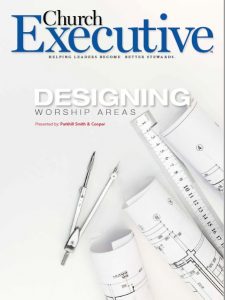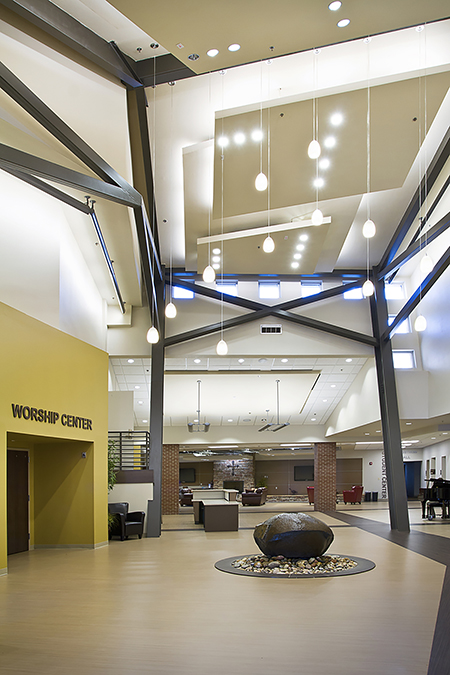
By Nick Cooper
If you’re beginning to think about a new facility, addition, remodel or relocation, you must first understand the culture and DNA of your congregation. Design should be an expression of those values aiding in your mission.
What are culture and DNA?
Culture is the direction, the focus of the church. It adapts with the community, demographics and spiritual vision given to it. Some focus on a culture of small-groups that meet off the church campus. Some primarily focus on a specific age group or bringing in new people. The point is that no culture is free from change.

DNA, by contrast, is a composition of the foundational principles, the core values. As cultures adapt, DNA is the compass around which all moving parts orient themselves. These are things like knowing baptism will be performed a certain way, studying the Bible, or affiliating with a denomination.
Here are some of the areas that can make the biggest difference in incorporating culture and DNA into your project:
Having a good grasp on project scope. How many times have you been to the buffet and gotten more food than you were going to eat? When our eyes are bigger than our stomachs on a church project, we are left with few options: spend and raise more money or scale back / value engineer the scope, which almost always leads to someone being disappointed.
This is the byproduct of starting with what you want to build rather than why you need to build. By studying and developing a clear picture of where you’ve been, who you are, and where you’re going, what to build will come into focus. You might see the need to build a 2,000-seat auditorium but only have parking for 500; thus, a change in scope will be necessary.
This might not seem like the most exciting way to start. But, in our experience, it will be the most successful.
 Design for DNA. Design around your core elements. For example, if you determined Bible Study is in your DNA, make sure you provide areas for people to do this.
Design for DNA. Design around your core elements. For example, if you determined Bible Study is in your DNA, make sure you provide areas for people to do this.
We designed a church a few years ago that was culturally focused on off-campus Bible Study. Realizing this could change, we built areas on-campus that could be repurposed into adult meeting spaces with changes like moving walls, new paint and furniture.
Small groups were the DNA; off-campus was the culture.
Be aware of the culture in your culture. As millennials have become the largest segment of our population, a design that incorporates an understanding of how they connect to one another and to the church is vital. Whereas previous generations have developed relationships through the corporate experience (i.e., move to a new city, go to church to meet friends), millennials connect very differently. They connect to a corporate experience through relationships (i.e., go to a church only after a friend invites them).
 Take a Sunday to watch where and how millennials interact with each other in your church. We bet you’ll find many of them in conversation where they pick up their children. Thus, the need for larger “soft” space areas, like hallways and seating areas, becomes vital. Even though it might seem like wasted square footage, keep in mind that they’re the largest segment of our population. If we want our churches to reach the next generation, we’ll have to provide for their culture with our designs.
Take a Sunday to watch where and how millennials interact with each other in your church. We bet you’ll find many of them in conversation where they pick up their children. Thus, the need for larger “soft” space areas, like hallways and seating areas, becomes vital. Even though it might seem like wasted square footage, keep in mind that they’re the largest segment of our population. If we want our churches to reach the next generation, we’ll have to provide for their culture with our designs.
Keep God in your design. It’s easy to approach a design solely from an analytical perspective. “What can we afford?” and “How much square footage do we need?” These are essential questions, but they can’t be the only questions. God must be in your design.
Noah spent years analyzing where he could build, staying out of flood plains, studying the amount of lumber needed, etc. Even after all that planning, the years of building, animals aboard and family packed, he still had one issue — how to shut the door. Genesis 7:16, explains how the door was closed: “the Lord shut him in.”
Did you catch that? If God hadn’t shown up, they still would have sunk.
I’ve always imagined ignoring God in design as building a door you can shut by yourself. Put your project in position to need God.
Take the time to define your culture and DNA, and stay focused on the correct areas.
Nick Cooper is Ministry Partner at Parkhill Smith & Cooper. He has a B.S. in Construction Engineering and spent 17 years ministering vocationally. He now works specifically with churches, developing strategies on topics ranging from reaching millennials to church design and construction.


